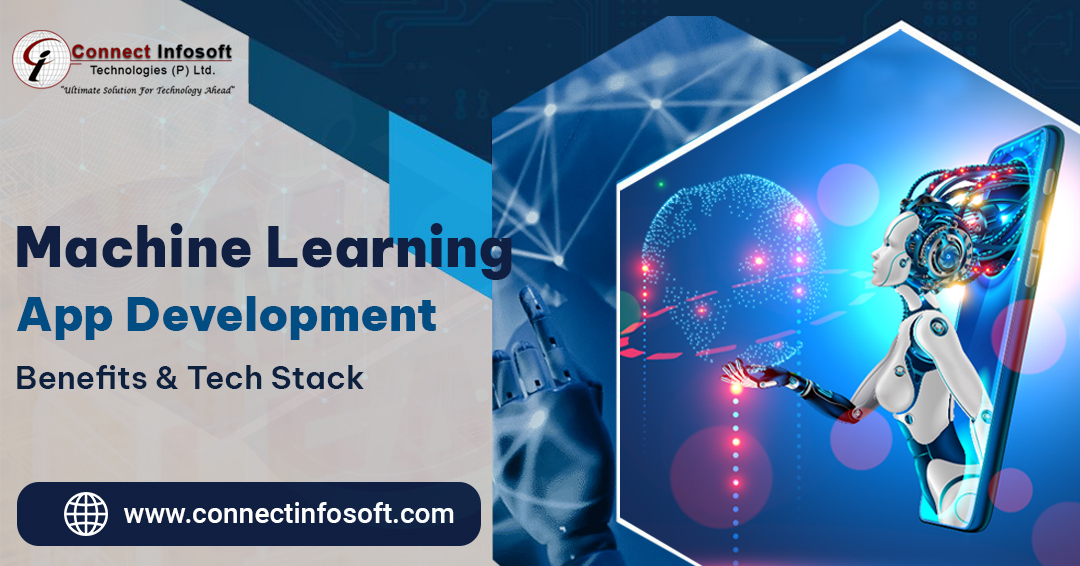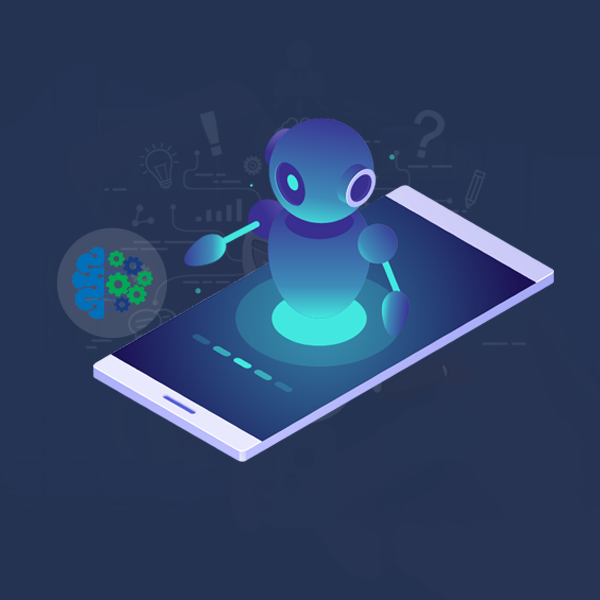Machine Learning App Development Benefits & Tech Stack - Connect Infosoft

Machine learning app development offers several benefits and requires a specific technology stack to implement the required functionality. Here are the key advantages and components of the tech stack for machine learning app development:
Benefits of Machine Learning App Development:
1. Automation and Efficiency:
Machine learning can automate repetitive tasks, streamline processes, and improve overall efficiency by leveraging algorithms that can learn and make predictions or decisions.
2. Data-Driven Insights:
Machine learning enables apps to extract valuable insights from large datasets, providing businesses with data-driven decision-making capabilities and a competitive edge.
3. Personalization and User Experience:
Machine learning algorithms can analyze user behavior and preferences to deliver personalized experiences, recommendations, and tailored content, enhancing user satisfaction.
4. Fraud Detection and Security:
Machine learning algorithms can identify patterns and anomalies in data, enabling applications to detect and prevent fraud, security breaches, and cyber threats.
5. Predictive Analytics:
Machine learning models can make accurate predictions based on historical data, enabling businesses to forecast outcomes, optimize operations, and make proactive decisions.
Tech Stack for Machine Learning App Development:
Programming Languages:
Python is widely used for machine learning due to its rich libraries and frameworks, including TensorFlow, PyTorch, and scikit-learn. Other languages like R and Java are also utilized.
Frameworks and Libraries:
Popular machine learning frameworks like TensorFlow, PyTorch, and scikit-learn provide pre-built tools and models for developing and deploying machine learning algorithms.
Data Processing and Analysis:
Apache Spark is a distributed data processing framework that can handle large-scale data processing and analysis, often used in conjunction with Hadoop.
Cloud Services:
Cloud platforms such as Amazon Web Services (AWS), Microsoft Azure, and Google Cloud Platform (GCP) provide scalable infrastructure and services for training and deploying machine learning models.
Development Tools and Environments:
Integrated development environments (IDEs) like Jupyter Notebook, PyCharm, and Visual Studio Code offer features for developing and testing machine learning applications.
Data Storage:
Depending on the requirements, machine learning apps may utilize databases like MySQL, PostgreSQL, or NoSQL databases such as MongoDB for storing and accessing data.
API Integration:
RESTful APIs are often used to integrate machine learning models and functionality into existing applications or systems.
Deployment:
Containerization technologies like Docker and orchestration tools like Kubernetes simplify the deployment and scaling of machine learning applications.
What is Machine Learning?
Machine learning is a subset of artificial intelligence (AI) that focuses on developing algorithms and models that allow computers to learn and make predictions or decisions without explicit programming. It involves the use of statistical techniques and computational algorithms to enable machines to analyze and interpret patterns and structures in data.
The core concept of machine learning is to train a computer system to recognize patterns and relationships within a dataset and use that knowledge to perform tasks or make predictions on new, unseen data.
Machine Learning App Examples
Machine learning has found numerous applications in various industries, leading to the development of innovative machine learning apps.
Here are a few examples of machine learning-powered applications:
- Virtual Personal Assistants: Siri, Google Assistant, and Alexa use machine learning to understand user commands and provide personalized responses.
- Recommendation Systems: Netflix, Spotify, and Amazon use machine learning to offer personalized recommendations.
- Fraud Detection: Machine learning detects fraudulent activities in finance by analyzing patterns and user behavior.
- Image Recognition: Facial recognition, autonomous vehicles, and content moderation rely on machine learning for accurate object identification.
- Healthcare Diagnosis: Machine learning analyzes medical data to assist in disease diagnosis and personalized treatment.
- Financial Market Analysis: Machine learning models analyze data to predict stock prices and aid investment decisions.
- Autonomous Vehicles: Machine learning enables object detection and decision-making in self-driving cars.
How to Build a Machine Learning App: Step-by-Step Process
Building a machine learning app involves a systematic step-by-step process. Here's a general outline of the key steps involved:
- Define the Problem: Clearly define the problem you want to solve with the machine learning app. Understand the objectives, requirements, and target audience for the application.
- Gather and Prepare Data: Collect relevant data that will be used to train and test the machine learning model. Ensure the data is properly cleaned, formatted, and preprocessed to remove noise and inconsistencies.
- Select an Algorithm: Choose the appropriate machine learning algorithm or a combination of algorithms that best fits the problem at hand. Consider factors such as the nature of the data, the desired outcome (classification, regression, etc.), and the available resources.
- Train the Model: Split the data into training and validation sets. Use the training set to train the machine learning model by feeding it with labeled data and optimizing its parameters. Continuously evaluate the model's performance on the validation set and fine-tune it as necessary.
- Evaluate and Validate: Assess the performance of the trained model using evaluation metrics relevant to the specific problem, such as accuracy, precision, recall, or F1 score. Validate the model's performance using separate test data that it has not encountered during training.
- Integrate the Model: Integrate the trained machine learning model into the application's codebase. This involves implementing the necessary APIs, interfaces, or wrappers to enable the app to interact with the model and make predictions.
- Develop the User Interface: Design and develop a user-friendly interface that allows users to interact with the machine learning features of the app. Consider the specific requirements and user experience principles relevant to your application domain.
- Test and Debug: Conduct thorough testing of the machine learning app to ensure its functionality, usability, and performance. Identify and fix any bugs, issues, or inconsistencies that may arise during testing.
- Deploy and Monitor: Deploy the machine learning app on the desired platform or infrastructure. Monitor its performance, gather user feedback, and track key metrics to continuously improve the application's performance and user satisfaction.
- Maintain and Update: Regularly maintain and update the machine learning app to address any new requirements, fix bugs, and incorporate improvements or new features. Stay updated with advancements in the field to leverage new techniques and algorithms.


